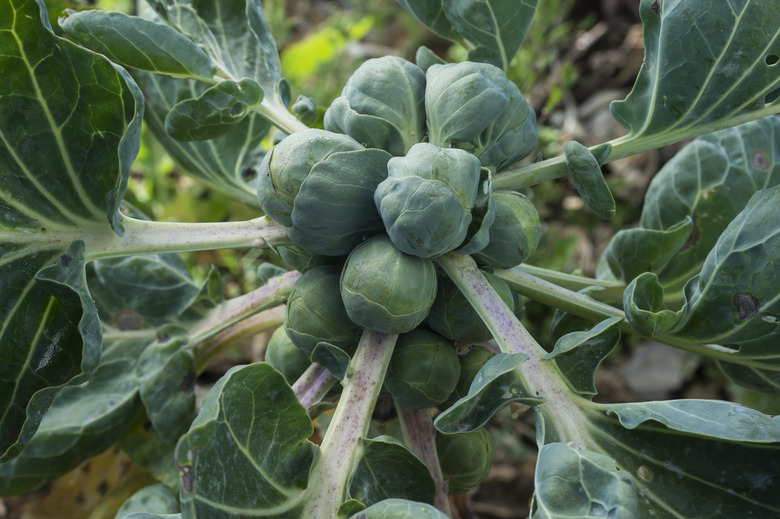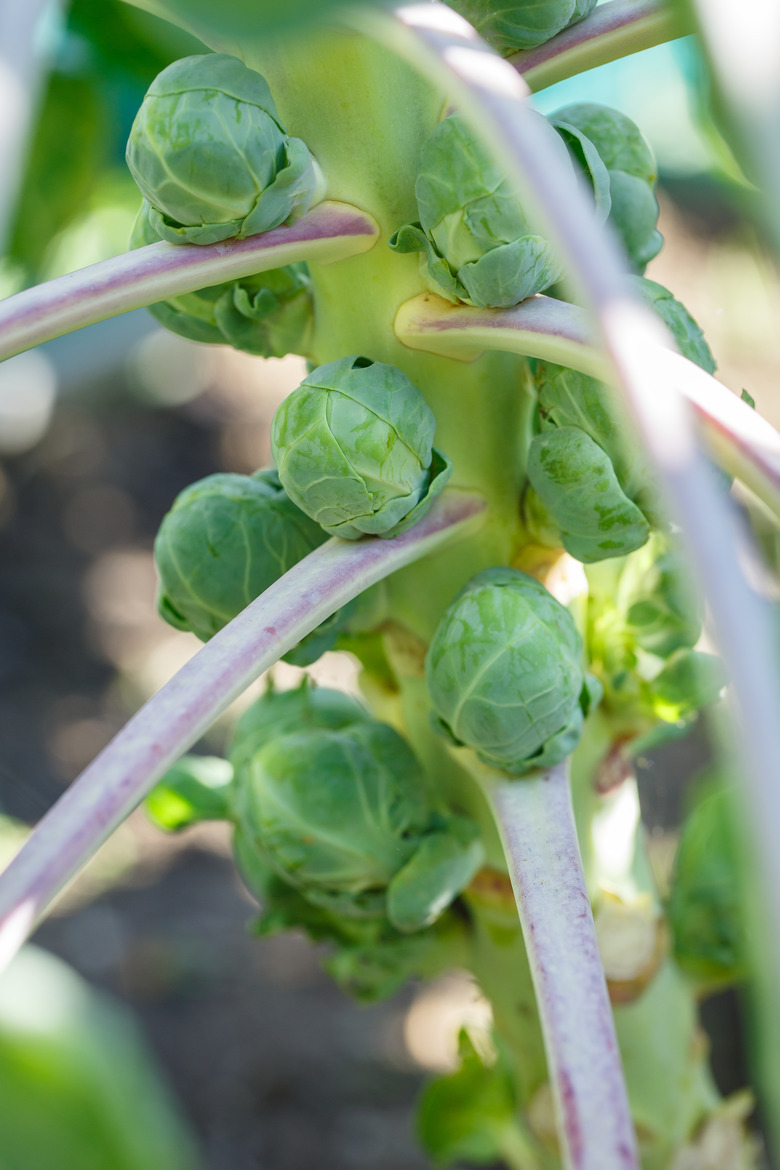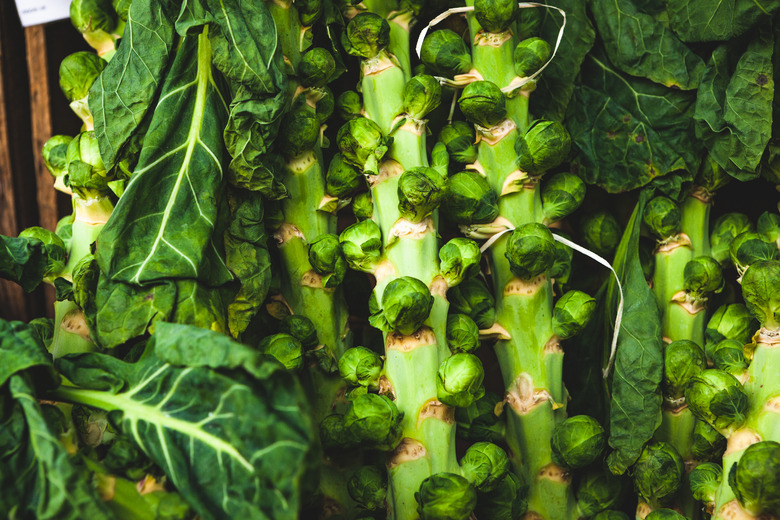How To Grow Brussels Sprouts
- Best uses for Brussels sprouts
- How to grow Brussels sprouts
- In what zone do Brussels sprouts grow best?
- When should you plant Brussels sprouts?
- Soil, sunlight and water recommendations for Brussels sprouts
- How to winterize Brussels sprouts
- How to harvest Brussels sprouts
- Common pests and other problems for Brussels sprouts
- Common diseases of Brussels sprouts
Brussels sprouts (Brassica oleracea [Gemmifera Group]) aren't everyone's idea of a perfect side dish, but there's no denying that they are good for you, and if you cook them in innovative ways, they can actually be quite tasty, even for kids. This cruciferous vegetable, which is part of the mustard family (Brassicaceae), originated in — you guessed it — Belgium, near the capital Brussels in the 1500s or even before, but the green and leafy miniature cabbages didn't make their first appearance in North America until 1800. Closely related to Mediterranean kale, its probable direct ancestor, the Brussels sprouts plant is easy to grow and makes a great addition to any vegetable garden.
Brussels sprouts love cool weather; they can be harvested after the first frost in Northern climates and in midwinter in Southern climates. The plant starts out looking like kale, but the stalk soon begins reaching upward, eventually reaching a height of 2 to 3 feet, and at maturity, it is topped with leafy green vegetation and studded with green, ball-shaped fruit that give it the appearance of a skinny green pineapple with a cabbage-like head. You harvest the fruit by picking it off the stalk (don't wait for it to fall off on its own), starting at the bottom of the plant and working your way up.
Brussels sprouts have a long growing season that can last from 80 to 130 days depending on the variety and growing conditions, and it can thrive in almost all North American climate zones, although the plant definitely prefers a nip of cold air, especially when it reaches maturity. It is not a decorative plant and hardly ever flowers, but because of its height and robust appearance, it's a stately presence in any vegetable garden.
Best Uses for Brussels Sprouts
Best Uses for Brussels Sprouts
Brussels sprouts belong primarily in a vegetable garden, and because they have to be placed fairly far apart, the spaces between them can be shared with lower-growing veggies with which they have an affinity, such as beets, celery, onions, radishes and potatoes.
While not technically an ornamental, Brussels sprouts can provide a dramatic highlight for a flower garden or herb garden and can benefit from the pest-deterring aromas of some flowers and herbs. Marigolds deter a number of pests and repel nematodes when tilled into the earth, and nasturtiums repel squash bugs and whiteflies. Some plants, such as basil, mint and garlic, protect Brussels sprouts with their pleasant or pungent aromas, and mustard can act as a trap crop, attracting insects that would otherwise attack the sprouts, allowing you to get rid of the pests by digging up the mustard plants.
Some cultivars are more decorative than others, and some are better suited to specific climatic conditions. Red Rubine is an heirloom variety with a striking purple hue that adds color to a combination veggie/flower garden, and the Jade Cross hybrid has a compact structure ideally suited to windy locations.
How to Grow Brussels Sprouts
How to Grow Brussels Sprouts
- Common Name: Brussels sprouts
- Botanical Name: Brassica oleracea (Gemmifera Group)
- When to Plant: Start seeds indoors in early May for a fall harvest. Transplant seedlings to the ground when the temperature is between 45 and 75 degrees Fahrenheit. In zones 9 to 11, plant from October to December.
- USDA Zones: Grow as an annual in zones 2-11
- Sun Exposure: Full sun
- Soil Type: Moist, well-draining soil
- When it's in Trouble: Wilting yellow leaves indicate overwatering or insufficient spacing and could also indicate acidic soil; add lime to bring the soil pH between 6.5 and 7.0.
- When it's Thriving: The stalk is straight and hardy, though it may need support, leaves are deep green and sprouts are well-formed.
Starting Brussels Sprouts From Seed
You can sow seeds directly in the ground, but because the long growing season necessitates early planting for a fall harvest, gardeners often start the seeds in trays or seed beds and transfer the seedlings to the ground when they are 4 to 6 inches tall. You can also grow Brussels sprouts in containers. Sow the seeds 1/4 to 1/2 inch deep in nutrient-rich, fertile soil after adding compost or fertilizer to build up thin soil, preferably a few weeks before planting to give the soil time to settle.
When you sow seeds in a tray, in a seed bed or in the ground, space them 4 inches apart in rows and thin them when they sprout (and each shows two leaves) to space the seedlings 18 to 24 inches depending on the variety; some hybrids stretch out more than heirloom varieties and need more space. When planting directly in the ground, choose the strongest-looking plants and cull the others by pinching off their leaves. Don't uproot them, or you may disturb the roots of the plants you want to keep. Maintain constant moisture in the soil by watering whenever the top of the soil feels dry.
Starting Brussels Sprouts From a Seedling
Because Brussels sprouts have a long growing season, you'll want to plant them with a fall or winter harvest in mind depending on your climate. In colder climates, a good rule of thumb is to plant seedlings a good four months before the first fall frost. If you aren't sure of the fall frost date, start the seeds three to five weeks before the final frost in spring. In warmer climates without freezing winters, start the seeds outdoors around midsummer for an early winter crop.
A few days before transplanting seedlings, amend soil as needed with compost or fertilizer and mix it in well. Check the soil and add lime if it's below 6.0 to prevent clubroot, a debilitating and common disease. Space seedlings 18 to 24 inches in rows that are 3 feet apart. Cover the base of each plant with mulch to prevent evaporation and to keep the ground moist.
In What Zone Do Brussels Sprouts Grow Best?
In What Zone Do Brussels Sprouts Grow Best?
Because the Brussels sprouts plant loves cool weather, it does best in Northern climates in zones 2 to 6 where the ground freezes over, provided that it gets in the ground early enough in the growing season. Because the season is shorter than in Southern climates, the seeds or seedlings have to be in the ground in the early spring to give the plants time to mature and produce a fall harvest. In zones 5 and higher, you may have enough time to harvest two crops if you plant a variety with an 80-day growing season and get the first crop in immediately after the last spring frost.
In warmer climates, you want to take advantage of the cooler winter months. Sow seeds in July in areas that have a longer growing season, transplant the seedlings in September, and you'll be able to harvest sprouts by mid to late winter.
When Should You Plant Brussels Sprouts?
When Should You Plant Brussels Sprouts?
Brussels sprouts will sprout from seed when the soil temperature is between 45 and 80 degrees, so you want to sow seeds outdoors only after the last spring frost. Most growers in Northern regions extend the growing season by sowing the seeds indoors about three to five weeks before the last frost and transplanting the seedlings in April or May. In Southern regions, it's important to avoid the scorching heat of summer, so outdoor seeding or transplanting is usually done in late summer or early fall when the dog days of summer are over and the ground starts to cool off.
Soil, Sunlight and Water Recommendations for Brussels Sprouts
Soil, Sunlight and Water Recommendations for Brussels Sprouts
Brussels sprouts need fertile, well-draining soil with a pH between 6.5 and 7.0. Amend soil with organic matter and fertilizer as needed and add lime to raise the pH if the soil is too acidic. Add nitrogen fertilizer at two- to three-week intervals during the first two months of the growing cycle.
The Brussels sprouts plant likes full sun and can handle only small amounts of shade. Be sure to place the plants in an exposed part of the garden far from trees or larger plants that block the sun.
To maintain vitality, Brussels sprouts plants need moist soil. Water the soil well before planting and continue watering at a rate of 1 to 1 1/2 inches per week. Keep the soil moist. If you notice it drying out, water again and consider adding more mulch to help retain moisture in the soil.
How to Winterize Brussels Sprouts
How to Winterize Brussels Sprouts
Strictly speaking, the Brussels sprouts plant is an annual, so you don't so much winterize it for a new season as you do maintain it during the winter while it's still growing. Before you harvest Brussels sprouts, it's a good idea to prune off the lower leaves to encourage the plant to put more energy into vegetable production. Continue doing this up to three weeks before harvest, which is ideally after the first frost, when the sprouts taste their best. In Southern climates, where a winter harvest is possible, the plants may be in the ground until early spring.
How to Harvest Brussels Sprouts
How to Harvest Brussels Sprouts
The ball-shaped sprouts are ready to harvest when they are 1 to 1 1/2 inches in diameter, and the ones on the bottom of the plant ripen first. Remove the bottom sprouts first, working your way up the stalk as the sprouts continue to ripen. If you planted for a fall harvest, the stalk may continue to produce sprouts until well past the first frost, especially if you remove all the leaves after picking the sprouts. They might not be quite as tasty, but they are still quite palatable.
Common Pests and Other Problems for Brussels Sprouts
Common Pests and Other Problems for Brussels Sprouts
Brussels sprouts need plenty of water, and if you don't give them enough, the leaves will wilt, and the stalks will be stunted. Besides this, there are few problems associated with growing this plant, but there are still some. Many of the pests that attack Brussels sprouts are the same ones that attack cabbage plants.
Like all members of the cabbage family, the Brussels sprouts plant has thick, meaty leaves that attract cabbage worms, which are caterpillars that will eat holes through them. Simply remove the worms by hand and relocate them. Cabbage loopers are also leaf-eating caterpillars, and you remove them the same way.
The small white butterfly, ubiquitous in much of the country during the summer months, deposits eggs on the underside of the leaves, so watch for them and remove them. If the eggs hatch, the larvae can quickly defoliate the plant. Remove the larvae by hand or by spaying the leaves with water.
Aphids congregate on the undersides of leaves and produce a sticky substance called honeydew that attracts ants. If left long enough, the honeydew promotes mold growth. You can remove aphids by spraying the leaves with a strong jet of water.
Flea beetles are small black beetles with strong back legs that give them the ability to jump like fleas. They eat holes in the leaves that can kill young plants, and they carry diseases such as wilt and blight. To get rid of them, spray the leaves with insecticidal soap or a permethrin- or pyrethrin-based insecticide.
Common Diseases of Brussels Sprouts
Common Diseases of Brussels Sprouts
Most diseases of which to be wary when you plant Brussels sprouts are fungal. Clubroot is a fungus that distorts the roots, inhibits plant growth and yellows the leaves. It can remain viable in the soil for 10 years, so if plants are affected, move next year's crop to a different location.
Downy and powdery mildew, white rust and ring spot all affect the leaves to varying degrees and may be managed by using a fungicide, if used as a preventive (before the presence of a diseases) instead of a curative (after a disease is present). Minimize these diseases it by rotating crops the following year.
Black rot is a bacterial infection that occurs when the weather is warm and the plants are continually wet. It wilts leaves and leaves black rings on the stems. Avoid irrigating with sprinklers and rotate crops to prevent it.
References
- Gardener's Path: A Flavor You've Come to Love: How to Grow Brussels Sprouts
- Vegetable Garden Guide: Become An Expert On How To Grow Brussel Sprouts
- The Old Farmer's Almanac: Growing Brussels Sprouts
- Missouri Botanical Garden: Brassica oleracea (Gemmifera Group)
- Edible Gardening: How to Grow Brussels Sprouts
- Plant Village: Brussels Sprouts


